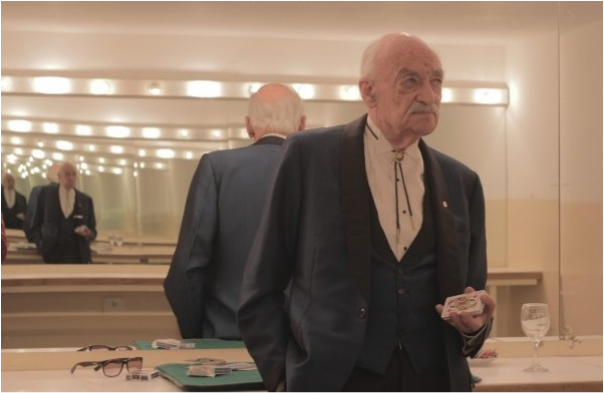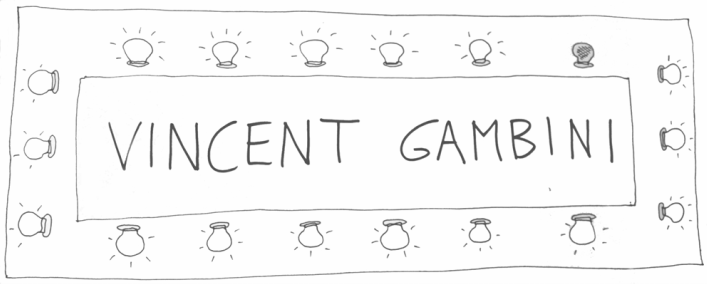 Still from the film El Gran Simulador (2013)
Still from the film El Gran Simulador (2013) Magic is fast.
When we think of a magician, particularly a sleight of hand magician, we think in terms of speed: the speed of execution, of concealment, of the swindle.
In a magic show things happen quickly and out of sight, the magician talking at a hurried pace, distracting the audience, and making that speed his subject material, for example through patter lines such as “the hand is quicker than the eye”, “now you see it now you don’t”, “hey presto”.
In music notation, the word presto denotes a quick tempo. The word ‘presti-digitation’ literally means “quick fingers”.
We could think of the quick tempo of magic as being analogue to that of the entertainment industries, of bite-sized attention spans, and the hurried production and consumption of images in what theorist Jonathan Crary has called terminal capitalism.
How to find another pace, another rhythm?
When a sequence of film or video images is slowed down, it becomes possible to see not only more, but differently. What was previously invisible gradually becomes visible; in the right conditions, we realise it is not just the images that have been slowed down, but ourselves too.
There is, or there might be, an alternative current of magic, never formalised as such, which we might describe as slow magic.
The initiator of slow magic would be the Argentinean René Lavand, who is widely regarded by magicians worldwide as one of the best practitioners of sleight of hand card magic. Lavand, who as a child lost his right hand in a car accident, performs masterful card sequences with his left hand only, whilst narrating carefully crafted stories, poems and anecdotes about life and art. Sat behind a table, he moves gracefully, with a deliberately slackened motion, occasionally pinpointed by small dramatic bursts.
The fact that he performs magic tricks with one hand of course raises the stakes, but what is truly remarkable is that he doesn’t attempt to “normalise” his performance, for example by showing that he can do with one hand what other magicians need two hands to accomplish. Lavand wears his wound visibly, his right arm at his side, hand tucked in his trouser pocket. Instead of trying to compete with the speed and skill set of two-handed magicians, he has chosen to sculpt a different approach altogether: that is, to go slower.
It is Lavand who, in one of his most celebrated pieces, makes up the term “lentidigitation’” (literally, “slow fingers”). The sequence involves him slowly and visibly mixing red and black cards, then showing how, like oil and water, they have inexplicably separated. He repeats this a number of times. The sense of wonder grows steadily: each time he repeats the sequence, he moves slower, more clearly, as if to show how the trick is done and how simple it is. And each time he spreads the cards and reveals that the colours have, once again, inexplicably separated, he declares, as if in a refrain:
No se puede hacer mas lento
(It can’t be done any slower)
Taking a cue from Lavand, then, slow magic is the kind of magic that emphasises slower rhythms, that is not in a hurry, or that even appears to disclose its own processes (but never its actual working methods: that is the one conservative limit of this performing art). Slow magic’s exhortation to audience members is: “LOOK AT THIS”. Spectators become detectives, forensic specialists, patient visitors at an art gallery.
I wonder, more generally, about the possible relations between slowness and enchantment, between doing things at a reduced tempo and a sense of marvel.
I think of the writer Nabokov as young boy in Russia, recounting the hours he spent watching the snow fall outside the window, waiting for his piano teacher to arrive (he was always late). He writes:
There was nothing to watch save the dark, muffled street and its receding line of loftily suspended lamps, around which the snowflakes passed and repassed with a graceful, almost deliberately slackened motion, as if to show how the trick was done and how simple it was.
The motion of falling snow becomes an event in its own right, unfolding over and over again before the young Nabokov, ‘as if to show how the trick was done and how simple it was’.
No se puede hacer mas lento…
Slow magic might have to do with the micro performances of everyday things: of snow, of leaves, of plastic bags (as demonstrated, if overdone, in the film American Beauty). It is about the myriad manifestations of matter, of things becoming, transforming, passing: as if to show how the trick was done and how simple it was.

 RSS Feed
RSS Feed